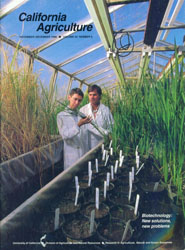


University of California
California Agriculture



|
|||
|
|||

Biotechnology: New solutions, new problems
Cover:
UC Davis geneticists Alfredo Lòpez De Leòn and Ram Chander Yadav are studying transgenic rice plants genetically engineered to resist bacterial blight... Photo by Jack Kelly Clark
November-December 1998
Volume 52, Number 6 |
|||
|
University of California, 1301 S. 46th St., Bldg. 478 Richmond, CA
|